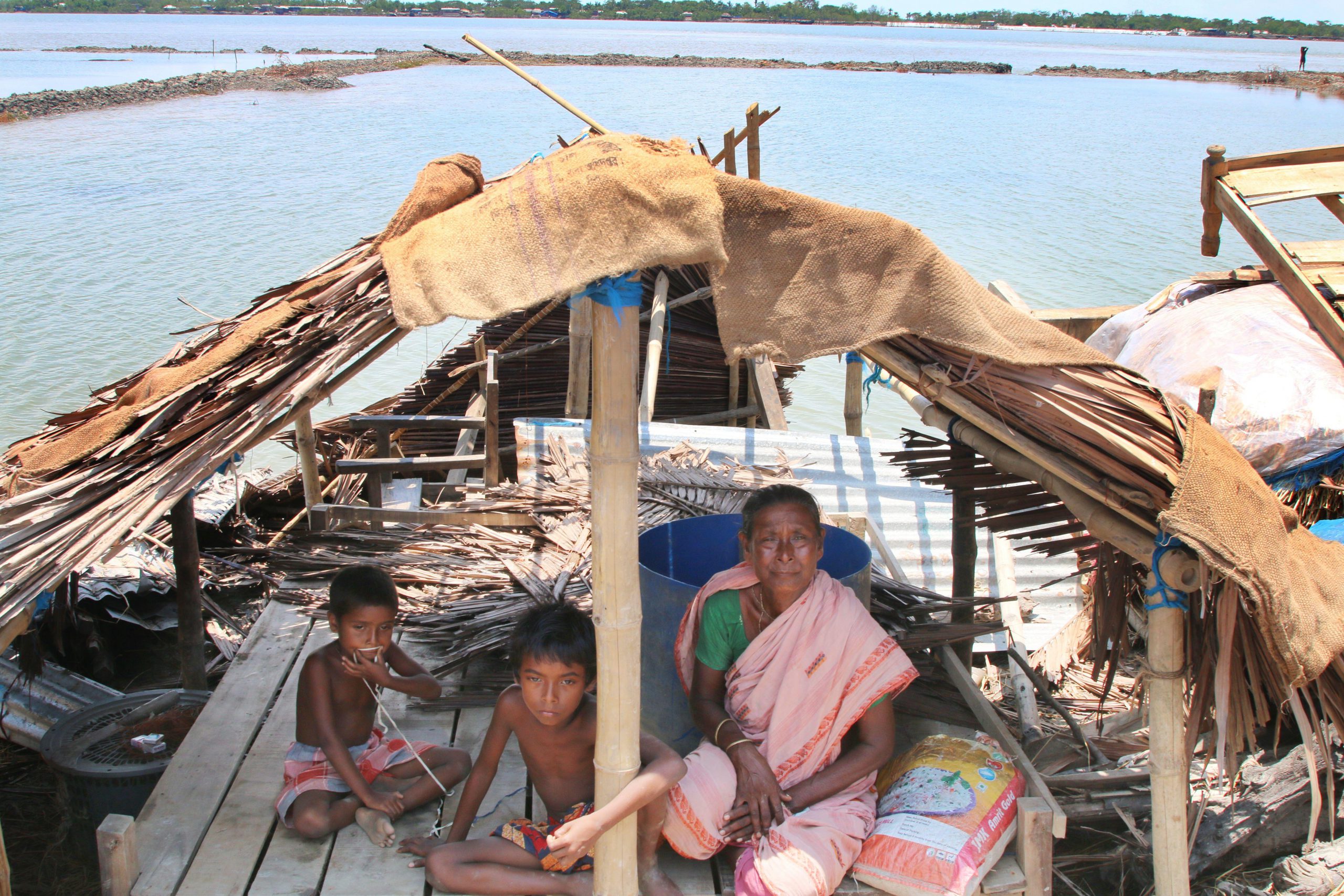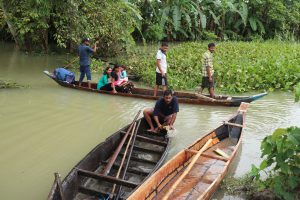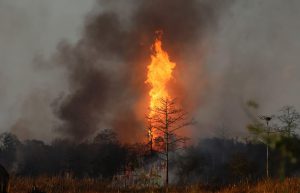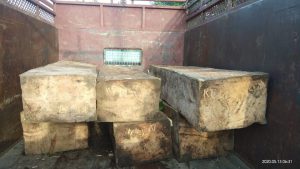Most of the indigenous population in the Sundarbans – earliest settlers among the five million-odd people who live in the deltaic archipelago of the world’s largest mangrove forest – lost their homes to Cyclone Amphan on May 20. Before this, their income had plummeted due to the lockdown forced by the Covid-19 pandemic.
Straddling Bangladesh and the Indian state of West Bengal, the Sundarbans – a world heritage site – bore the brunt as Cyclone Amphan made landfall at 165-175 kilometres per hour (kmph) and gusting up to 185 kmph. Most of the indigenous residents live in the Gosaba area of the Sundarbans, away from the coastline facing the Bay of Bengal. But even there, the cyclone was strong enough to flatten the mud huts in which they lived.
“The storm damaged almost all the mud houses extensively. Breaches in the embankments around Chhoto Mollakhali and Kumirmari islands near Gosaba have led to huge saline water inundation. Apart from sweeping away many mud houses this may also prove disastrous for agriculture – as happened during Aila,” said Gopal Mondal, a school teacher based in Chhoto Mollakhali. Cyclone Aila had hit the region in 2009, leading to more than 300 deaths and over a million displaced.
![Satjelia homes submerged by Amphan [image by: Gopal Mondal]](https://dialogue.earth/content/uploads/2020/06/Satjelia_homes_submerged_by_Amphan_-_pic_Gopal_Mondal.jpg)
The Sundarbans, a tidal forest on the Bay of Bengal shore, is a maze of rivers and creeks where the water level rises and falls a metre twice a day. Amid the maze, people live in small islands protected by embankments. An embankment breach means salt water getting into farms and freshwater ponds, killing crops and fishes, the main sources of livelihood.
A week after Amphan had passed, the authorities were still too busy distributing food, drinking water and tents to start repairing embankments. Mondal – who is trying to organise some support for the indigenous people – said locals were trying to fix the breaches themselves.
Anurag Danda, a researcher with the think tank Observer Research Foundation, has been working in the Sundarbans for decades. He pointed out that hardly any indigenous person owns any land, and most are dependent on what they can gather from the forests around them. Leaders of local indigenous groups allege that most of them do not get any of the support earmarked under various government schemes.
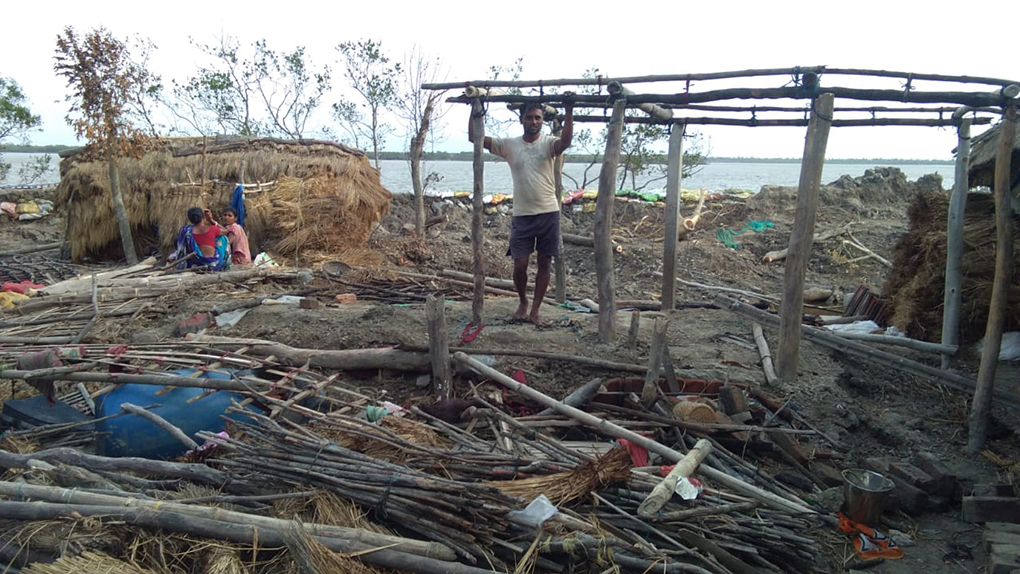
‘We have Lost everything’
“We have lost everything. First the lockdown is not allowing us to go close to the forest for more than two months and collect fishes and crabs, our main source of livelihood. And now this cyclone has taken away our shelter and almost all belongings barring one cot,” said Biswajit Mirdha (name changed on request), a resident of Chhoto Mollakhali.
Through a repeatedly disrupted phone call, Mirdha said the thatched roof of his mud house had blown away, while the walls were partially damaged in the wind; and then the embankment in nearby Kalidaspur was breached by the surging waves brought by the cyclone. The hut, and everything around it, were swept away. His neighbours gave him a tarpaulin sheet under which he and his family have been living for a week.
“I do not know how long we can survive like this,” Mirdha said. “Since the lockdown started, we are getting free rice, both the Aila quota of 16 kg a month for a family and [now] 2 kg additionally per person. But you cannot survive just on rice.” This rice quota was instituted after Cyclone Aila.

“Yes, providing permission to enter forest areas has been stopped during lockdown,” Ravi Kant Sinha, head of forest force in the state government, confirmed to The Third Pole.
Lockdown and Amphan are like killing a person twice
The experience of the Mirdha family is now the rule rather than an exception. Anil Murmu, who stays in Adibasipara village – one of the largest towns in the Sundarbans – had to helplessly watch the roof of his mud house being blown away by the cyclone. Murmu – a labourer in an aquaculture operation – had just completed repairing his thatched roof. It had been damaged by Cyclone Bulbul last November. This time, the four-member family hid in a corner of the roofless hut. They consider themselves lucky because the walls did not fall down.
“I have never seen such a storm in my life. Bulbul was huge, but this one seemed to be hell-bent on destroying everything. Every cyclone seems to be getting more monstrous,” said Laboni Murmu, veteran resident of the same village.
Santi Sardar from Satjelia – another village in the Sundarbans – lost her husband to a man-eating tiger a few years back. Now her earnings have dwindled to “almost nothing” as livelihood options like collecting prawn seedling for the hatcheries or working as unskilled labour has also come to a standstill due to the lockdown. Amphan has damaged most of her belongings. “The cyclone was like killing a person twice,” she said.
“The price of crabs used to be about INR 800 (USD 11) per kilogramme. Before the Corona spread, most of it was exported. Now the price has come down to INR 100-150 (USD 1.32-1.98) per kg, said Tuhin Ghosh, professor in the Department of Oceanography in Jadavpur University, Kolkata. Ghosh, who has been studying the Sundarbans for years, said there is no market for crabs even if someone entered the forest illegally to collect them.
According to information received by Ghosh, recently three men from Chhoto Mollakhali and Satjelia were killed by tigers while fishing in the protected forest zone. Two of them were from indigenous communities, he said.
Lack of support
A local official said that after Cyclone Amphan, indigenous people are receiving the same relief material as everyone else. But at other times, only a fraction of them receive the support earmarked for indigenous peoples under various central and state sponsored schemes, he admitted.
Sunil Hembram, an indigenous community member who lives near Canning, said, “We receive almost no support from the government. Maybe we are not important as we form a small part of the electorate.”
In Satjelia, the elected head of a panchayat (local government unit) told this reporter that 43% of the indigenous people living in the area under her jurisdiction had received the earmarked support. Indigenous residents called that an exaggeration.
Early settlers
Indigenous peoples were moved into the Sundarbans by the then British authorities in the 1830s, which makes them among the earliest settlers in the area. Most were brought from areas with large indigenous populations in what are now the states of West Bengal, Jharkhand and Odisha. For centuries before that, few people dared to settle in the Sundarbans for fear of tigers. When British entrepreneurs needed labourers to cut down trees for timber, they worked on the assumption that indigenous peoples were more used to living close to forests, and would be less scared of tigers.
With the felling of trees banned for decades, the landless indigenous population depends on fishery, crab collection and honey collection. All are affected now, even the health-sapping work done by women of spending up to 12 hours a day mostly submerged in brackish water to gather prawn fries for sale to hatcheries. Resident Subodh Sardar said, “The price of a prawn fry used to be around a rupee (a little over 1 US cent) or marginally more before. It has nosedived as the middlemen are not buying in the absence of market demand. As a result, our income has come down to almost nothing.”
“The indigenous population has been extremely poor, predominantly landless,” said Subhash Acharya, a retired official of West Bengal government’s Sundarbans affairs department. “Most stay at the edge of villages. They are hardly in the mainstream. Their vulnerability also comes from limited livelihood options like going to the forest area to catch crabs and fishes.”
Another resident, Pabitra Mandal, said honey ready for collection in the forest is being wasted. “We were having a discussion with the administration regarding honey collection. Cyclone Amphan has put it off again.”
Add to this the collapse of the remittance economy, on which the Sundarbans residents have depended for years. With migrant workers thrown out of their jobs due to the nationwide lockdown and returning home penniless, few have any idea on how they will survive.
